1998 GMC SIERRA power steering
[x] Cancel search: power steeringPage 95 of 452
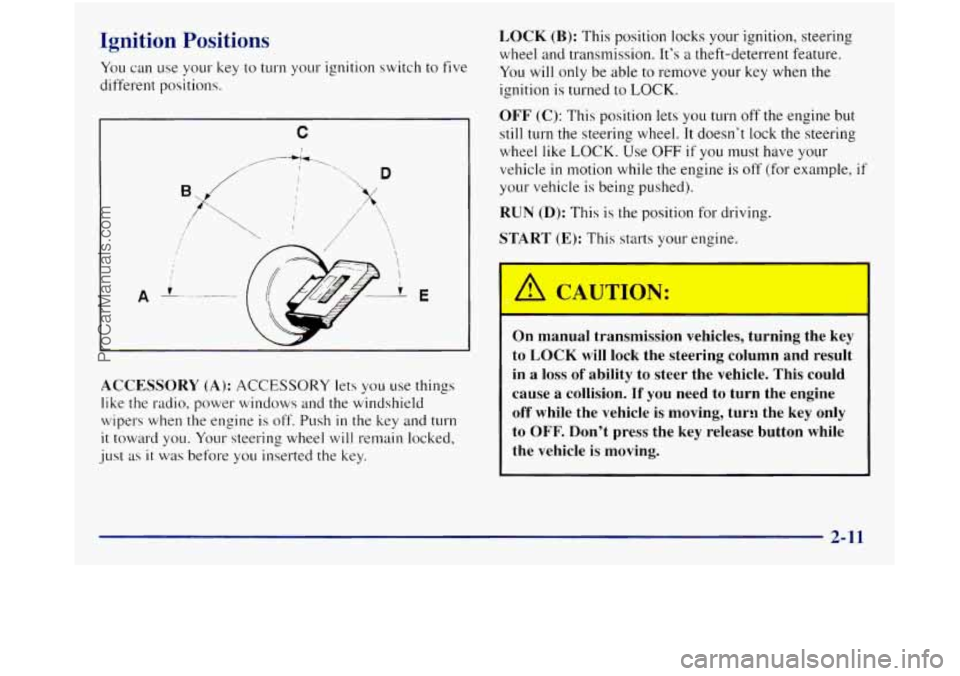
Ignition Positions
You can use your key to turn your ignition switch to five
different positions.
C
I
E
LOCK (B): This position locks your ignition, steering
wheel and transmission. It’s a theft-deterrent feature.
You
will only be able to remove your key when the
ignition
is turned to LOCK.
OFF (C): This position lets you turn off the engine but
still turn the steering wheel. It doesn’t lock the steering
wheel
like LOCK. Use OFF if you must have your
vehicle
in motion while the engine is off (for example, if
your vehicle is being pushed).
RUN (D): This is the position for driving.
START (E): This starts your engine.
ACCESSORY
(A): ACCESSORY lets you use things
like the radio, power windows and the windshield
wipers when the engine
is off. Push in the key and turn
it toward you. Your steering wheel will re~nain locked,
just
as it was before you inserted the key.
~ On manual transmission vehicles, turning the key
to LOCK
will lock the steering column and result
in a loss
of ability to steer the vehicle. This could
cause
a collision. If you need to turn the engine
off while the vehicle is moving, turn the key only
to
OFF. Don’t press the key release button while
the vehicle is moving.
I
2-11
ProCarManuals.com
Page 98 of 452

Engine Coolant Heater (If Equipped)
In very cold weather, 0°F (- 1 SOC) or colder, the engine
coolant heater can help. You’ll get easier starting and
better fuel economy during engine warm-up. Usually,
the coolant heater should be plugged in a minimum of
four hours prior to starting your vehicle.
To Use the Engine Coolant Heater
1. Turn off the engine.
2. Open the hood and unwrap the electrical cord.
The engine coolant heater electrical cord
is located
on the driver’s side
of the engine compartment, near
the power steering reservoir.
3. Plug it into a normal, grounded 110-volt AC outlet.
Plugging the cord into an ungrounded outlet
could cause an electrical shock.
Also, the wrong
kind
of extension cord could overheat and cause
a fire. You could be seriously injured. Plug the
cord into a properly grounded three-prong 110-volt
AC outlet. If the cord won’t reach, use a
heavy-duty three-prong extension cord rated for
at least
15 amps.
4. Before starting the engine, be sure to unplug and store
the cord
as it was before to keep it away from moving
engine parts.
If you don‘t, it could be damaged.
How long should you keep the coolant heater plugged
in? The answer depends on the outside temperature, the
kind of
oil you have, and some other things. Instead of
trying to list everything here, we ask that you contact
your dealer
in the area where you‘ll be parking your
vehicle. The dealer can give
you the best advice for that
particular area.
ProCarManuals.com
Page 196 of 452
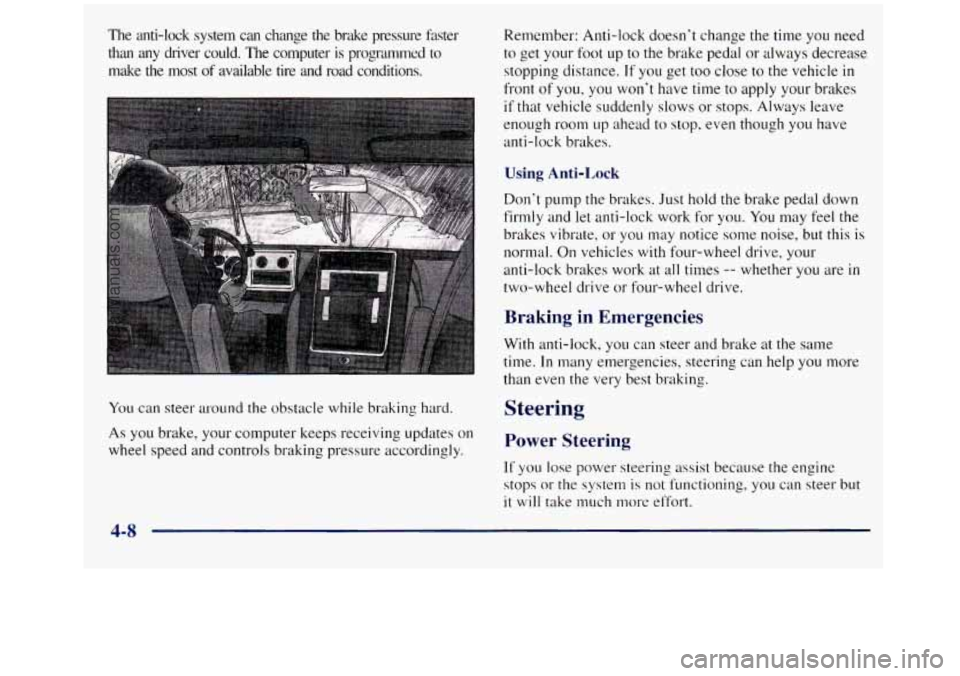
The anti-lock system can change the brlzke pressure faster
than any driver could. The computer is programmed
to
make the most of available tire and road conditions.
You can steer around the obstacle while braking hard.
As you brake, your computer keeps receiving updates on
wheel speed and controls braking pressure accordingly. Remember: Anti-lock doesn’t change the
time you need
to get your foot
up to the brake pedal or always decrease
stopping distance.
If you get too close to the vehicle in
front of you, you won’t have time to apply your brakes
if that vehicle. suddenly slows or stops. Always leave
enough room
up ahead to stop, even though you have
anti-lock brakes.
Using Anti-Lock
Don’t pump the brakes. Just hold the brake pedal down
firmly and let anti-lock work for you.
You may feel the
brakes vibrate, or you may notice some noise, but this is
normal. On vehicles
with four-wheel drive, your
anti-lock brakes work at all times
-- whether you are in
two-wheel drive or four-wheel drive.
Braking in Emergencies
With anti-lock, you can steer and brake at the same
time. In many emergencies, steering can help you more
than even the very best braking.
Steering
Power Steering
If you lose power steering assist because the engine
stops
or the system is not functioning, you can steer but
it will take much more effort.
4-8
ProCarManuals.com
Page 207 of 452
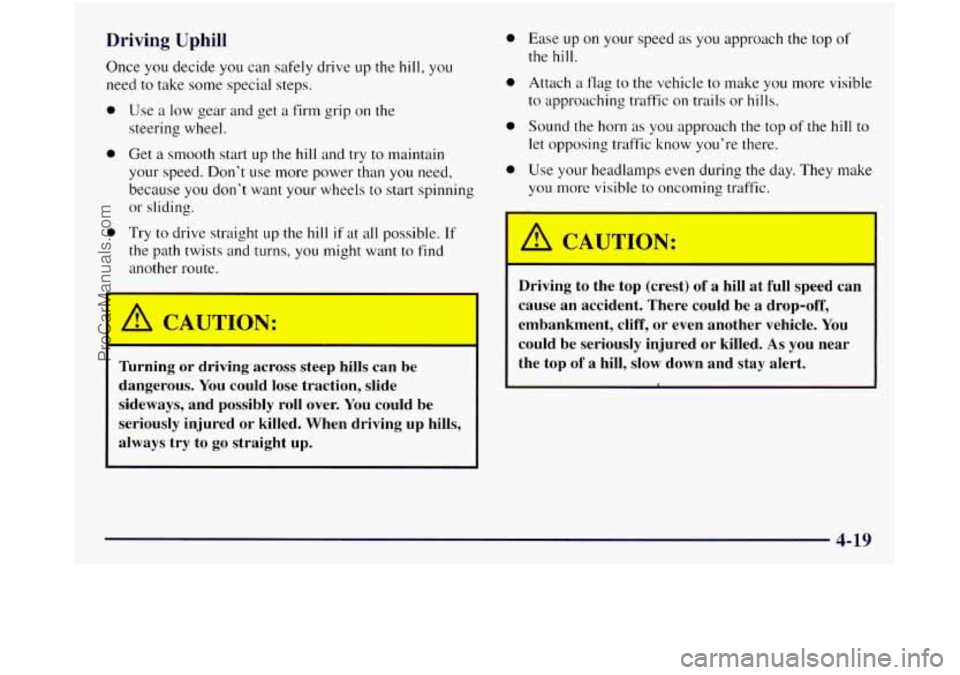
Driving Uphill
Once you decide you can safely drive up the hill, you
need to take some special steps.
0
0
0
Use a low gear and get a firm grip on the
steering wheel.
Get a smooth start
up the hill and try to maintain
your speed. Don’t
use more power than you need,
because you don’t want your wheels to start spinning
or sliding.
Try to drive straight up the
hill if at all possible. If
the path twists and turns, you might want to find
another route.
l A C * UYON:
0
0
0
0
Ease up on your speed as you approach the top of
the hill.
Attach a flag to the vehicle to make you more visible
to approaching traffic on trails or hills.
Sound the horn as you approach the top
of the hill to
let opposing traffic know you’re there.
Use your headlamps even during the day. They make
you more visible to oncoming traffic.
Turning or driving across steep hills can be
dangerous. You could lose traction, slide
sideways, and possibly roll over. You could be
seriously injured or killed. When driving up hills,
always try to go straight up.
1 A CAUTION:
Driving to the top (crest) of a hill at full speed can
cause an accident. There could be a drop-off,
embankment, cliff, or even another vehicle. You
could be seriously injured or killed.
As you near
the top of a hill, slow down and stay alert.
4-19
ProCarManuals.com
Page 263 of 452
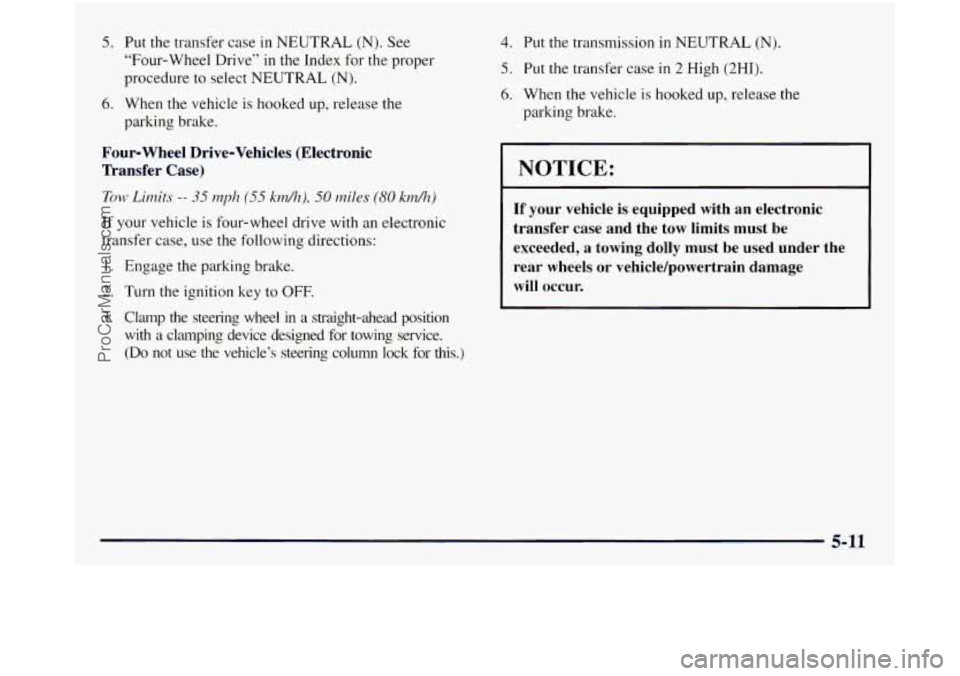
5. Put the transfer case in NEUTRAL (N). See
“Four-wheel Drive” in the Index
for the proper
procedure to select NEUTRAL
(N).
6. When the vehicle is hooked up, release the
parking brake.
4. Put the transmission in NEUTRAL (N).
5. Put the transfer case in 2 High (2HI).
6. When the vehicle is hooked up, release the
parking brake.
Four- Wheel Drive-Vehicles (Electronic
Transfer Case)
Tow Limits -- 35 mph (55 krdh), 50 miles (80 krn/l1)
If your vehicle is four-wheel drive with an electronic
transfer case, use the following directions:
1. Engage the parking brake.
2. Turn the ignition key to OFF.
3. Clamp the steering wheel in a straight-ahead position
with a clamping device designed for towing service.
(Do not use the vehicle’s steering column lock for this.)
NOTICE:
If your vehicle is equipped with an electronic
transfer case and the tow limits must be
exceeded, a towing dolly must be used under the rear wheels or vehicle/powertrain damage
will occur.
5-11
ProCarManuals.com
Page 265 of 452
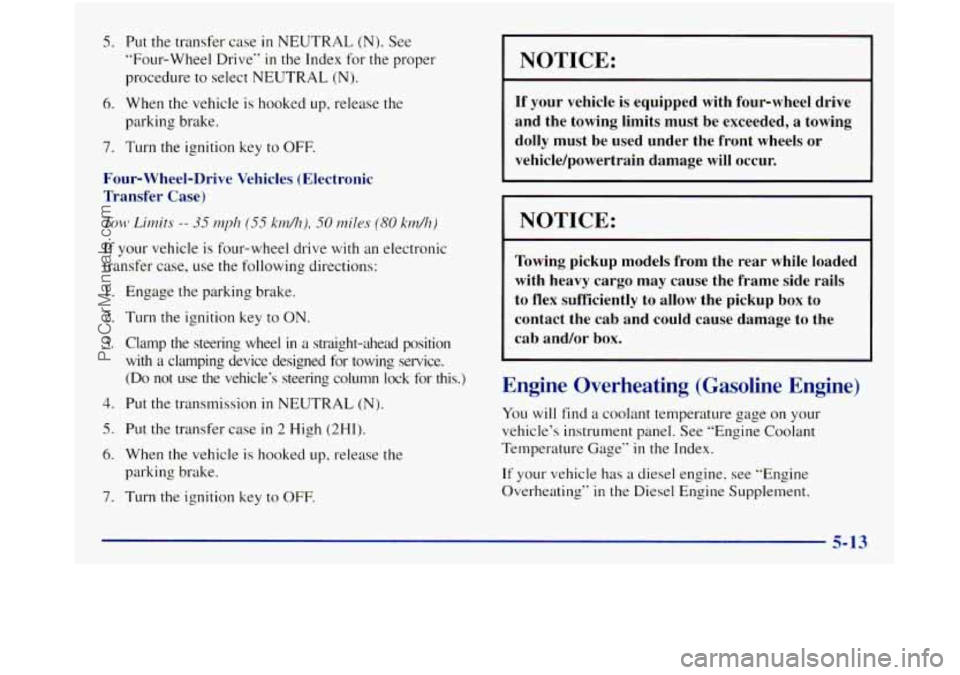
5. Put the transfer case in NEUTRAL (N). See
“Four-Wheel Drive’’
in the Index for the proper
procedure to select NEUTRAL
(N).
6. When the vehicle is hooked up. release the
parking brake.
7. Turn the ignition key to OFF.
Four- Wheel-Drive Vehicles (Electronic
Transfer Case)
Eml Limits -- 35 mph (55 km/JZ), 50 milc?s (80 kndh)
If your vehicle is four-wheel drive with an electronic
transfer case, use the following directions:
I. Engage the parking brake.
2. Turn the ignition key to ON.
3. Clamp the steering wheel in a straight-ahead position
with
a clamping device designed for towing service.
(Do not use the vehicle’s steering column lock for this.)
4. Put the transmission in NEUTRAL (N).
5. Put the transfer case in 2 High (2HI).
6. When the vehicle is hooked up, release the
parking brake.
7. Turn the ignition key to OFF.
NOTICE:
If your vehicle is equipped with four-wheel drive
and the towing limits must be exceeded, a towing
dolly must be used under the front wheels or
vehicle/powertrain damage will occur.
I NOTICE:
Towing pickup models from the rear while loaded
with heavy cargo may cause the frame side rails
to flex sufficiently to allow the pickup box to
contact the cab and could cause damage to the
cab and/or box.
Engine Overheating (Gasoline Engine)
You will find a coolant temperature gage on your
vehicle’s instrument panel. See “Engine Coolant
Temperature Gage”
in the Index.
If your vehicle has a diesel engine, see “Engine
Overheating”
in the Diesel Engine Supplement.
5-13
ProCarManuals.com
Page 291 of 452

Section 6 Service and Appearance Care
Here you will find information about the care of your vehicle. This section begins with service and fuel information,
and then it shows how to check important fluid and lubricant levels. There is also technical information about your
vehicle, and
a part devoted to its appearance care.
6-2
6-3
6-5
6-6
6- 8
6-9
6- 13
6- 14
6-18
6-2
I
6-24
6- 25
6-26
6-26
6-28 6-32
6-32 Service
Fuel (Gasoline Engine)
Fuels
in Foreign Countries (Gasoline Engines)
Filling Your Tank (Gasoline Engine)
Filling a Portable Fuel Container
Checking Things Under the Hood
Noise Control System
Engine Oil (Gasoline Engine)
Air Cleaner Filter (Gasoline Engine)
Automatic Transmission Fluid
Manual Transmission Fluid
Hydraulic Clutch
Rear Axle
Four-wheel Drive
Engine Coolant Radiator Pressure Cap (Gasoline Engine)
Thermostat
, 6-33
6-3 3
6-35
6-39
6-39
6-50
6-5
1
6-6 1
6-62
6-65 6-69
6-70
6-70
' 6-76
6-77 6-79 Power
Steering Fluid
Windshield Washer Fluid
Brakes
Battery
Bulb Replacement
Windshield Wiper Blade Replacement
Tires
Appearance Care
Cleaning the Inside
of Your Vehicle
Cleaning the Outside of Your Vehicle
Appearance Care Materials Chart
Vehicle Identification Number (VIN)
Electrical System Replacement
Bulbs
Capacities and Specifications
Air Conditioning Refrigerants
6-1
ProCarManuals.com
Page 301 of 452
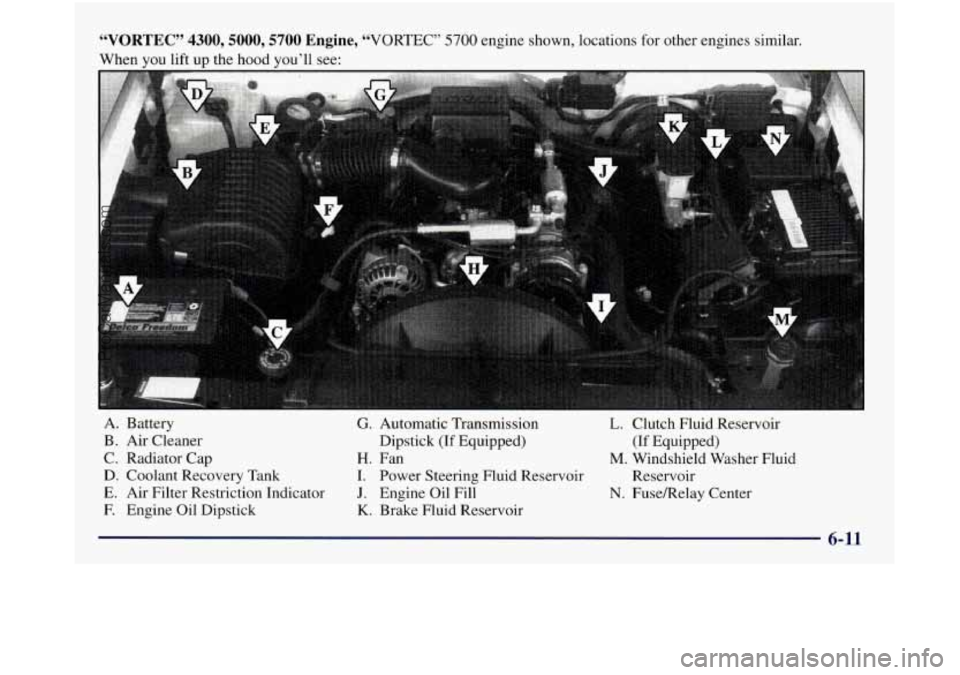
“VORTEC” 4300,5000,5700 Engine, “VORTEC” 5700 engine shown, locations for other engines similar.
When you lift
up the hood you’ll see:
A. Battery
G. Automatic Transmission L. Clutch Fluid Reservoir
B. Air Cleaner
Dipstick
(If Equipped) (If Equipped)
C. Radiator Cap H. Fan M. Windshield Washer Fluid
D. Coolant Recovery Tank I. Power Steering Fluid Reservoir Reservoir
E. Air Filter Restriction Indicator J. Engine Oil Fill N. FuseRelay Center
F. Engine Oil Dipstick K. Brake Fluid Reservoir
6-11
ProCarManuals.com